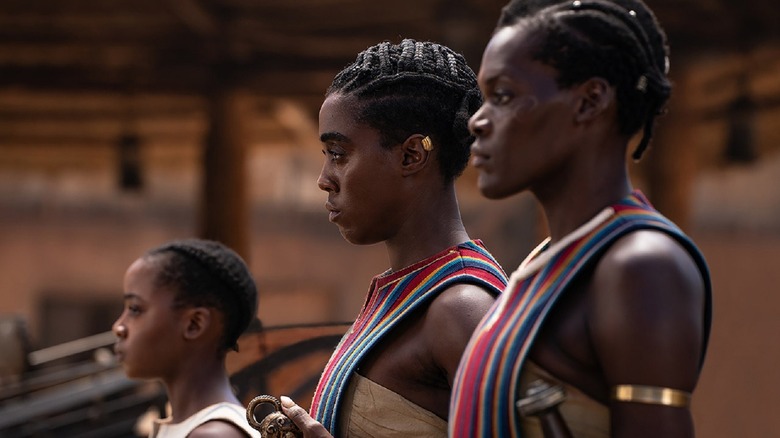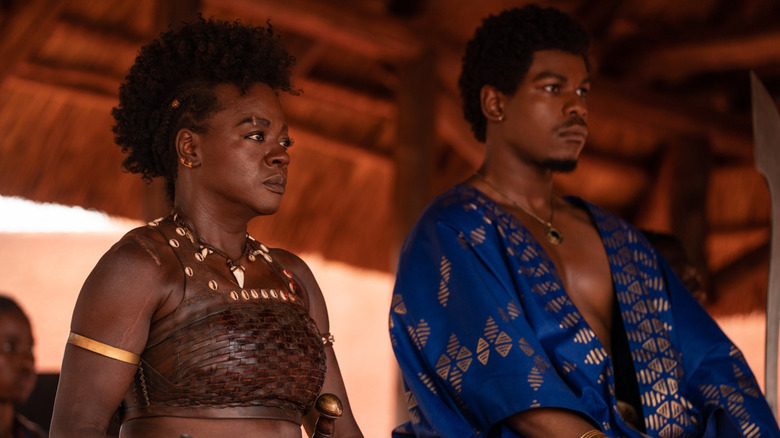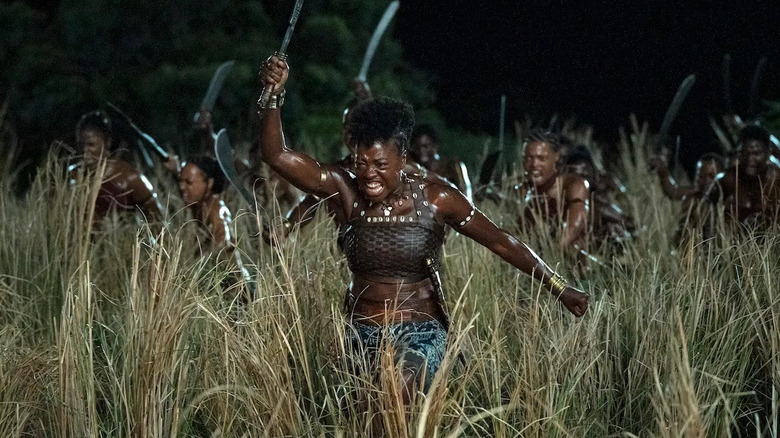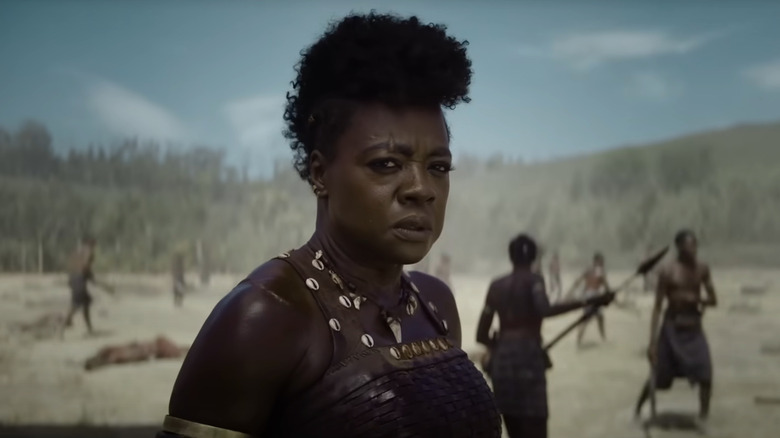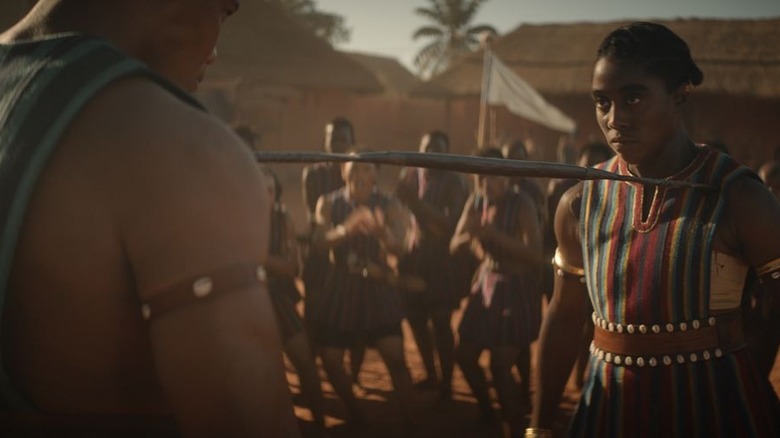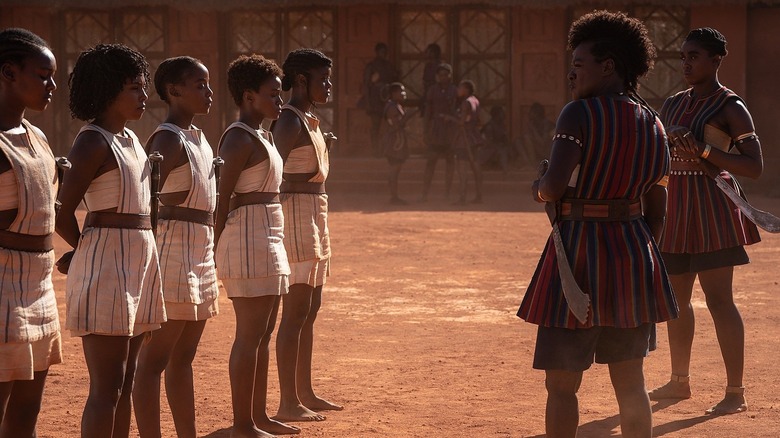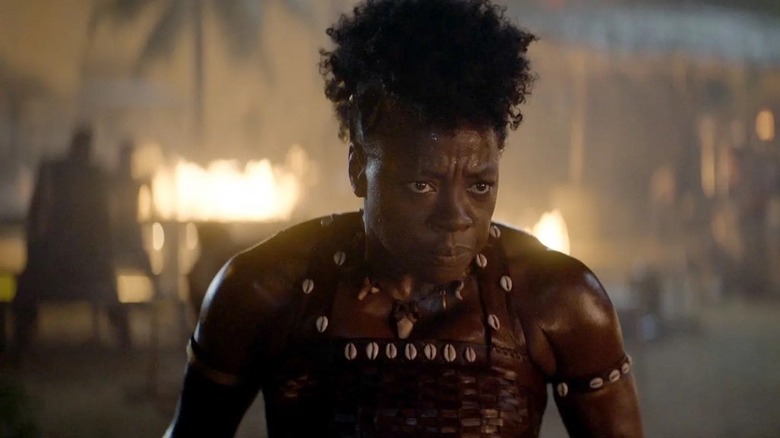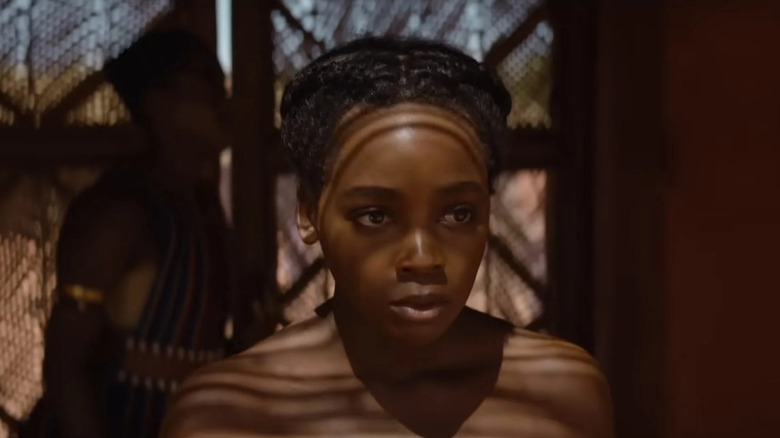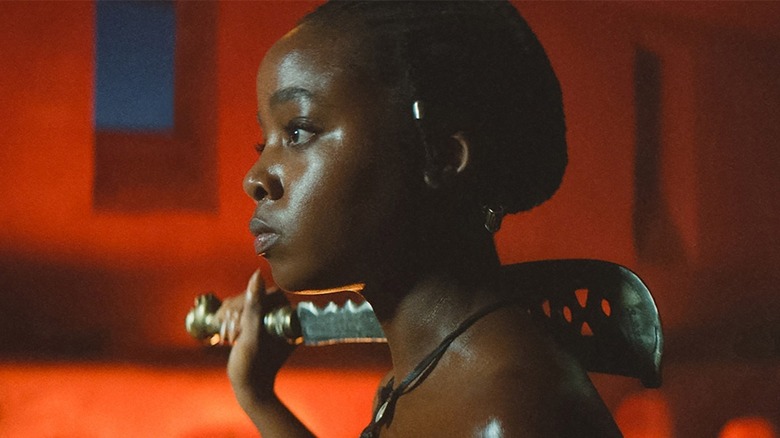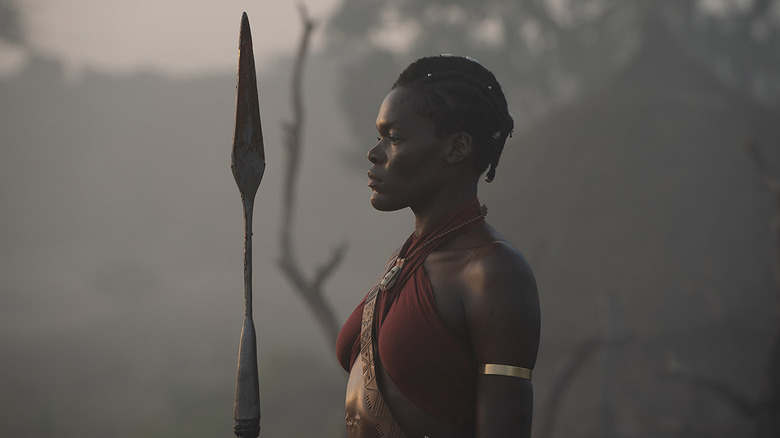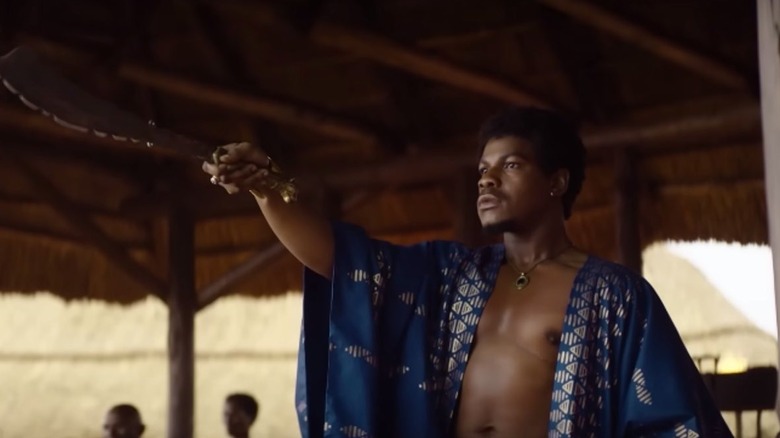Small Details You Missed In The Woman King
"The Woman King" is directed by Gina Prince-Bythewood and stars Viola Davis as the leader of the legendary all-woman army the Agojie in the early 19th century. The film is celebrated for bringing to the screen an all-black female lead production of talented dark-skinned actresses (via Forbes). However, "The Woman King" is less than accurate in telling the tale of the West African kingdom of Dahomey where the Agojie hailed from.
Historically speaking, the Dahomey kingdom played a large hand in pushing the slave trade within Africa. King Ghezo (played in the film by John Boyega) and his kingdom flourished under his rule of selling African people as slaves. While this movie does touch on the dark history of this powerful kingdom, it chooses to focus on the story of the Agojie women, presenting the idea that not everyone within the kingdom agreed with the king's decision to sell people for money. So while this film may be dubbed as being "based on true events," it follows suit with many other films boasting to be historically accurate. The lines between fact and fiction are blurred. But this doesn't stop the film from being a powerful representation of women so often left in the shadows in Hollywood. And thanks to outstanding performances from its stellar cast, "The Woman King" has broken new ground, opening to acclaim with a current Rotten Tomatoes rating of 95% and an audience score of 99%.
With such a powerful story to tell, it's no doubt that the film ties in small details that one is likely to catch upon a second or even third watching. Below, we've compiled a list of the most interesting details you probably missed when watching this epic film.
Hints at why the ending is intentionally uplifting
The story of the Dahomey kingdom is a dark one indeed. "The Woman King" does not shy away from showcasing that its characters took part in selling people as slaves to European slave owners. However, by the film's end, King Ghezo chose to stop his kingdom's participation in the slave trade, opting to move into selling palm oil. Unfortunately, this isn't historically accurate. According to Smithsonian Magazine, King Ghezo did stop his involvement in the slave trade for a short while. Looking to palm oil as a new form of trade. However, he quickly returned to the slave trade and was succeeded by his son, Glele, who only stopped the slave trade when the British government forced him to as they had abolished slavery in its colonies in 1833 (via Insider). Aside from the financial gain, the king was likely pressured by the idea that his kingdom would either have to sell slaves or become enslaved.
Kim Fain, an English professor at Texas Southern University and author of "Black Hollywood: From Butlers to Superheroes, the Changing Role of African American Men in the Movies," discussed with CBC why the reimaging of black trauma in this film is intentional, and not meant to harm historically accurate facts. Fain said, "Everything that seemed to be coming out for a while was not necessarily showing us as heroes, but showing us as victims. [...] It almost ... retraumatizes us, culturally and individually." Therefore, transforming this film into something that a community can celebrate was an entirely deliberate move for the filmmakers. They wanted the story to stop when King Ghezo moved from the slave trade to palm oil, focusing on the tales of the women rather than that of the king.
Black Panther's Dora Milaje was inspired by the Agojie
Before "The Woman King" released in theaters, audiences were given another film to showcase an all-female powerhouse of warriors, the Dora Milaje in "Black Panther." However, did you know that the Dora Milaje were inspired by the true story of the Agojie? These female warriors were so impressive and so brutal in battle, that the European and American settlers who visited the Dahomey kingdom nicknamed the warriors the "Dahomey Amazons," as their power was similar to that of Amazonian legend (via History vs Hollywood).
Long before "The Woman King" came to life, the real-life warriors had great influence on the culture of Wakanda (per Time). In 1998, comic writer Christopher Priest introduced the idea of the Dora Milaje to comic book readers. They were described as being "Deadly Amazonian high school karate chicks" who were also the King's "wives-in training." Hmm, this sounds slightly familiar.
As described in "The Women Soldiers of Dahomey," the Agojie women were all considered to be wives of the king and would reside within the palace walls. This was to protect the soldiers from having a family or being with any man. And although they were granted this elevated position, they were also ready to lay their lives down for their king, as they were considered to be the last line of defense.
Black Panther helped greenlight The Woman King
According to Aje-Ori Agbese, an expert on African cinema at the University of Texas Rio Grande Valley, "The Woman King" was only greenlit due to the success of "Black Panther." Agbese told Ms. Magazine that they have that Marvel film to thank for allowing "The Woman King" to tell a story that is "centered on African women and African history." She believes films like these "will generate a conversation" (per Smithsonian Magazine).
The story for "The Woman King" was co-written by actress and producer Maria Bello after she learned about the Agojie during a trip to Benin in 2015. From there, it was an uphill battle to find a studio that was willing to finance the project. The film's director, Gina Prince-Bythewood, told the Los Angeles Times that "It was a constant push and fight to convince people that we deserve a big budget, that we deserved to tell a story like this." Enter "Black Panther." The Dora Milaje are a group of all-female warriors that became incredibly popular after the release of the 2018 film. These women are inspired by the Agojie, and it's because of their warm reception and the success of Marvel's film, Prince-Bythewood said, that "The Woman King" was given the greenlight to be made at all. Luckily, whoever doubted that this story could be successful was proven wrong.
The importance of the spear test
The film showcases the brutal training that the Agojie warriors went through during the rule of King Ghezo in the Dahomey kingdom. However, "The Woman King" uses one of the training methods as a form of foreshadowing within the story. Lashana Lynch portrays the charismatic warrior Izogie. In the film, audiences watch as Izogie takes part in a competition with a male warrior. They have a large, sharp spear digging into their shoulders, suspended between them, and every step one of them takes, the spear is pushed deeper in. Whoever gives into the fear and pain first loses. Izogie is seen barely flinching as the spear pierces her skin, causing her wound to bleed. In fact, the only time she shows emotion is when she wins the competition, screaming in joy and victory over her accomplishment.
This is an important moment, as it showcases how the Ahojie training values fearlessness and pushing beyond pain. This idea is sprinkled various times throughout the film but is most importantly used in General Nanisca's (Viola Davis) final fight against her abuser, General Oba Ade (Jimmy Odukoya). He moves to stab Nanisca, and she deflects with her hand, resulting in the dagger going right through her skin. Instead of being distracted by the fear and pain, she uses the dagger that is still deep in her hand and turns it around to stab Oba Ade, defeating him. Like they say in "Dune": Fear is the mind-killer.
Nawi's training
Portrayed by Thuso Mbedu, Nawi is a new recruit brought to the king as a gift by her adoptive father. He considers her to be "untamable," as she refuses to be married off to an older abusive man. Nawi welcomes the idea of becoming an Agojie warrior, believing it will empower her and prevent her from being a victim.
"The Woman King" follows Nawi throughout her training as she aims to achieve her goal. Audiences watch as she struggles with long-distance running, the ability to cut off a head in one swing, and tying knots with her rope. Upon a first watch, you're likely to see this as a way to show her training, but each struggle holds significance for Nawi's survival. For example, when Nawi stays behind to help Nanisca during her first fight with Oba Ade, they must run to avoid capture. Luckily, Nawi is able to easily keep up with Nanisca, proving she's grown and learned from her training, and they both make it out alive.
When Nawi and the other recruits go through an obstacle course to pass their final test, the end sees Nawi take the head off a dummy in one swing, resulting in her victory over everyone else. Because of this, she's honored by the king as being the best of the warriors.
And finally, the knot in a rope. Once Nawi passes the test to become a member of the Agojie, she is brought into a real battle and is shown using a dagger gifted to her by Malik (Jordan Bolger). The dagger is expertly tied to a rope, allowing her to keep it close at all times. Every piece of training we watch her go through adds to her survival as a warrior.
The importance of the name Nanisca
Academy Award-winning actress Viola Davis portrays the Agojie general Nanisca. By the film's end, she is crowned as the woman king and is able to convince King Ghezo to abandon their involvement in the slave trade. She argues that they should turn their heads to more admirable causes, such as selling palm oil. Although this isn't the historically accurate ending for the Dahomey kingdom's involvement in the slave trade, there is some truth to Davis' character name, Nanisca.
Although the character is a fictional one, the name Nanisca holds importance. According to Smithsonian Magazine, there were reports from French naval officer Jean Bayol in 1889. Upon a visit he made to the Dahomey kingdom, he witnessed a teenager complete her training by taking part in a brutal final test. This is a similar version of events that the film details with Hero Fiennes Tiffin's character, Santo Ferreira. According to Jean Bayol, the name of the teenager he witnessed training was Nanisca, and he watched as she killed a man and swallowed the blood from her sword. While General Nanisca is a fictional character, she is likely to have been named after this real woman who was a part of the Agojie army.
A tribute to the real-life Nawi
Similar to Viola Davis' character, Nanisca, Nawi was also a real person who fought for the Dahomey kingdom as an Agojie warrior. She was considered to be the last known surviving Agojie who actually had experience fighting in battles. She died in 1979 at over 100 years old (via Smithsonian Magazine). While the character that Thuso Mbedu portrays in "The Woman King" is not the same Nawi from history, the character and her name are a tribute to this historically relevant woman.
Nawi is also another connection between "Black Panther" and "The Woman King." Lupita Nyong'o, who plays Nakia in "Black Panther," visited Benin (once the Dahomey kingdom) to learn about the Agojie. A 2019 Smithsonian Channel special follows Nyong'o as she learns about the Agojie culture. In the special, she visits with locals who have shared knowledge about the Agojie that's been passed down from generation to generation. Nyong'o is taken on a tour of artifacts and cultural performances; however, she is thought to have also encountered the last of the Agojie. Nyong'o meets an older woman whom the locals describe as having been trained by the last of Agojie warriors as a child years past (via The Guardian). However, unlike the real Nawi, this woman never truly saw a battle.
Nawi's nails
When audiences first meet Lashana Lynch's Izogie, she is in the heat of battle. Audiences watch as she uses her extremely long nails to gouge out the eyes of the man she is fighting. Once Izogie meets Nawi, the young recruit is immediately impressed by her. She greatly admires Izogie, hoping to one day be just like her. Izogie in turn also takes a liking to Nawi, showing her how to sharpen her nails just as she does. And for anyone paying close enough attention, you're able to see that Nawi ends up doing just that.
Once Nawi passes her test and becomes an Agojie warrior, she finds herself being captured after her first battle. Luckily, she sees that Izogie is there with her, and the two plot their escape from being sold as slaves. After a distraction is caused, they make a run for it, but Nawi is caught, resulting in Izogie's returning for her. And unfortunately, she gets shot in the process. While Nawi holds her dying mentor in her arms, audiences can briefly see that her nails are long and sharpened, just as Izogie's had been. This hints at the idea that Nawi will become just like Izogie, and with her death, that's exactly what happens. The final scene of the film sees Nawi standing in Izogie's place as the third commander with Nanisca and her right-hand woman, Amenza (Sheila Atim).
The various fighting techniques included in the film
As the Agojie are a group of skilled warriors, "The Woman King" includes many violent scenes that showcase just how brutal these women could be during their battles. Fight coordinator Johnny Gao and choreographer Jénel Stevens previously worked on "Black Panther," "Avengers: Infinity War," and "Avengers: Endgame." Stevens worked as a Dora Milaje stunt performer; however, she told CinemaBlend that the two properties were incredibly different from each other, and this mainly had to do with the variety of fighting styles introduced in this film.
"A lot of us came in with different backgrounds in the core stunt team," Stevens said. "They trained the South African performers in South Africa before we even got there." According to Stevens, the film incorporates martial art styles such as wushu, kali, jiu-jitsu, and judo. The actresses took part in intense forms of training to prepare for their role as Agojie warriors (per The Credits). They engaged in weapons training, stunt coordination, and choreography months before shooting ever began. In the days leading up to the film's release, Viola Davis shared her workout routines on her Instagram page, highlighting the hard work and dedication the entire cast and crew had when creating this film (via PopSugar).
Why John Boyega took a back seat
"The Woman King" has incredible talent in its cast. From Academy- and Emmy Award-winner Viola Davis to the newest person to hold the mantle of 007, Lashana Lynch, the film has no shortage of massive talent. However, one name that might quietly fade to the background is that of the incredibly charismatic John Boyega. Boyega portrays the divisive character of King Ghezo. He is the ruler of the Dahomey kingdom and controls the actions of the Agojie warriors. However, he's not seen for the majority of the film. And that's intentional.
As "The Woman King" strays away from the darker historical facts about King Ghezo to focus on the women, Boyega's version of the king becomes more of a secondary character. And that's not a problem with the actor. He told The National News that his involvement with this project is purely out of excitement, saying, "I would have been in it even if it was a walk-on part. [...] I wanted my name to be mentioned when they say that this is one of the projects that prompts conversations in the industry. I wanted to be there to witness that cultural moment, to share it with the audience, so they can be a part of the celebration of that change that I think is steadily coming." Boyega understands what the filmmakers are trying to create with a story that centers these fierce women warriors. He said that he did not see the film as a career-boosting move for him and that he instead chose to be involved with the film because of the power of its story and its potential to change the industry conversation around films with majority-Black casts, especially spotlighting Black women, and focusing on South Africans and the African diaspora.
